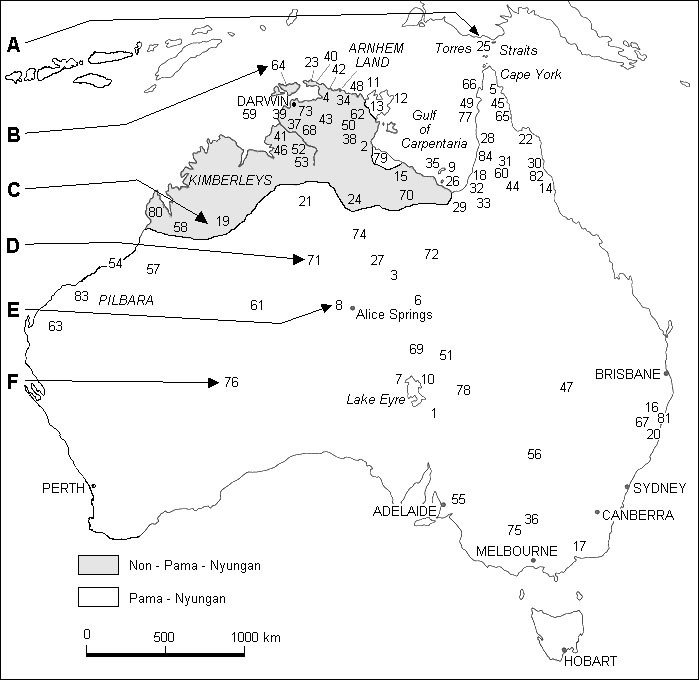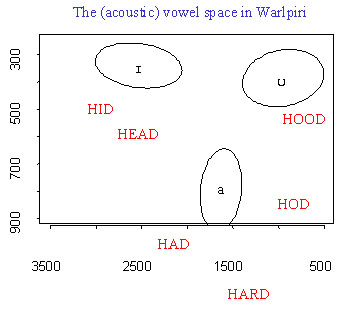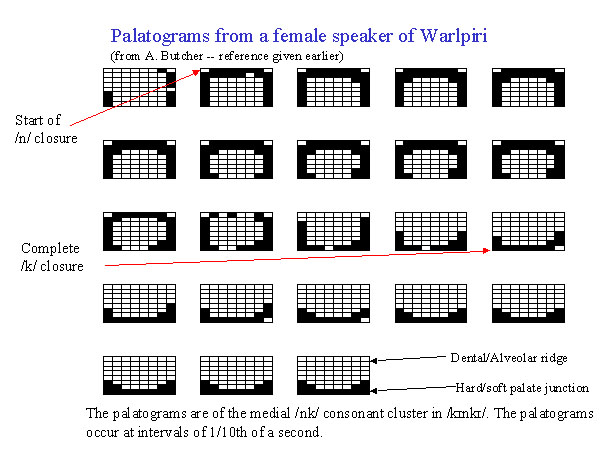Australian Aboriginal languages
The phonetics and phonology of Australian Aboriginal languages
Jonathan Harrington
Important: You must have installed the phonetic font "Charis SIL" or tested this installation to determine if the phonetic characters installed properly.
Australian languages past and present
1788
- Approximately 700 tribes speaking 250 different langs.
- Each tribe had an average of about 500 members.
- Largest: multitribe Western Desert [76], 1/2 million sq miles and about 6000 speakers.
2000
- more than 100 languages have become extinct since 1788.
- approximately another 100 are known only to old people and are not being learned.
- 20-25 are being actively learned by children. About 50,000 Australians have some knowledge of an Aboriginal language.
- Most Aboriginal languages are likely to be extinct in the next 100 years.
Early analyses of Aboriginal languages
First speech sounds written down
Words written from Guugu Yimidhirr[22], when the Endeavour was being repaired in N.E. Qld. in 1770.
Recognition that there was more than one Aboriginal language
1788. None of the Guugu Yimidhirr words could be understood in Sydney.
First attempt at grammar
Lieutenant William Dawes gathered paradigms of verbs and sentences. Notes taken to a London library and not uncovered until 1972. Only record of Dharuk.
First language extinction
Tasmania invaded in 1803 -- worst genocide, little written down.
Recognition that Australian languages are inter-related
Captain George Grey in explorations on W.A. -- published in 1841, noted phonological similarities between words in languages in W.A, S.A, and NSW. Further developed by E.M. Curr in 1840.
Distribution of Aboriginal languages
Map of Australia showing the distribution of Aboriginal Languages

Languages with the largest numbers of speakers
A [25] Kala lagaw Ya (3000-4000 speakers)
B [64] Tiwi (1500)
C Walmajarri (1000
D [71] Warlpiri (3000)
E [8] Arrernte (1500)
F [76] Pitjantjara and Ngaanyatjarra; both dialects of Western Desert (3500)
Adapted from: Evans, N. (1995). "Current issues in Australian languages". In Handbook of Phonological Theory, ed. Goldsmith, J. Blackwell
See a key to the language numbers on the map.
Pama-Nyungan (PN) languages
('Pama' and 'nyungan' mean 'man' in the N.E. and S.W. extremities of the PN region)
3/4 of Australian langs. are typologically similar having:
- similar phoneme inventories
- morphological suffixation
- NP case marking
- pronouns show singular, plural, and dual.
Non-Pama-Nyungan (NPN)
- make use of suffixes AND prefixes
- they show which NP is subject or object by information in the verb
- phonologically very similar to PN languages.
Relationship between Australian and other languages
Australian languages are self-contained; there is no evidence that they are synchronically related to languages beyond the Australian continent, except:
- Torres Strait islanders (are Papuan in physical type and culture).
- Western island languages are similar to Australian langs.
- Eastern island languages are related to PNG languages.
Examples of loan words
| Dharuk | (Sydney) | "boomerang", "dingo", "koala", "wallaby", "wombat" |
| Nyungar | (Perth) | "jarrah" |
| Gamilaraay | (East NSW) | "budgerigar", "galah", "mulga" |
| Guugu Yimidhirr[22] | (N.E. Qld.) | "kangaroo" - from /ɡaŋʊrʊ/ |
| Wemba wemba | (W. Victoria) | "mallee", "yabby" |
| Wiradhuri | (S.W. NSW) | "kookaburra" |
NB: 'cockatoo' from Malay; 'bandicoot' from Telegu, Southern India
Dixon, R. (1993). In Schulz, G. (ed) 'The Languages of Australia'.
(All these languages are long extinct except Guugu Yimidhirr)
Example of a Warlpiri [71] Dialogue
|
/ɲarpaɹa kʊranpa janʊ piraɳɪ/ where did you go yesterday? | |
|
/jatɪcaraɳa janʊ -- kʊjʊkʊ manʊ mɪjɪkɪ/ I went north -- to (look for) meat and vegetable food. | |
|
/palka majɪnpa kʊjʊcʊ pakaɳʊ/ Did you get any meat? | |
|
/lawa kʊjʊwaŋʊ jaticaracʊ mɪjɪ mɪpaɳa manʊ piraɳɪɭɪcɪ/ No, there's no meat there to the north. I only got vegetable food yesterday. |
Dialogue 13b. In Laughren, M., Hoogenraad, R., Hale, K., Japanangka Granites, R. (eds).
A Learner's Guide to Warlpiri. IAD Press: Alice Springs.
Typical consonant system (phonemic) of Australian languages
| Peripheral | Apical | Laminal | ||||
| labial | velar | alveolar | post-alveolar | dental | palatal | |
| stop | p | k | t | ʈ | t̪ | c |
| nasal | m | ŋ | n | ɳ | n̪ | ɲ |
| lateral | l | ɭ | l̪ | ʎ | ||
| rhotic | r | ɹ | ||||
| glide | w | j | ||||
Atypical features of the consonant phonemes in Australian languages:
- 85% of the world's languages have a voicing contrast
- most of the world's languages have twice as many obstruents as sonorants
- six nasal place distinctions is unknown outside the Australian continent.
Commonly used orthography
(Developed in the last 30 years)
| Peripheral | Apical | Laminal | ||||
| labial | velar | alveolar | post-alveolar | dental | palatal | |
| stop | p | k | t |
ʈ (rt) |
t̪ (dh or th) |
c ( j or tj) |
| nasal | m |
ŋ (ng) | n |
ɳ (rn) |
n̪ (nh) |
ɲ (ny) |
| lateral | l |
ɭ (rl) |
l̪ (lh) |
ʎ (ly) | ||
| rhotic |
r (rr) |
ɹ (r) | ||||
| glide | w |
j (y) | ||||
e.g.
[22] Guugu Yimidhirr = /ɡʊːɡʊ jɪmɪt̪ɪr/
[71] Warlpiri = /waɭpɪɹɪ/
Vowel systems (phonemic) of Australian languages
|
Three vowel systems (common in PN languages) |
Five vowel systems (many NPN languages) | ||||||||
| High | ɪ | ʊ | ɪ | ʊ | |||||
| e | o | ||||||||
| Low | a | a | |||||||
|
and a length contrast /ɪ ɪː ʊ ʊː a aː/ | |||||||||
|
Two vowel system (rarer, but possible eg. Arrernte [8]) | ||
| High | ə | |
| Low | a |
Languages like Arrernte have lost the /ɪ ʊ/ rounding contrast in the vowel and developed instead separate rounded consonant phonemes, e.g. unrounded /k/ vs. rounded /kʷ/: /akʷaŋəɲə/ ('left hand') /akaŋkəmə/ ('smiling')
The (acoustic) vowel space in Warlpiri

Acoustic measurements of about 100 citation form vowels from a female speaker of Warlpiri [71]. The x- and y- axes (frequency in Hertz) are the first two resonances of the vocal tract that are proportional approximately to tongue backness and tongue height. The figure also shows typical values for a female speaker of Australian English.
Stress and vowel reduction
Most Aboriginal languages don't reduce their vowels to schwa in lexically unstressed syllables (in contrast to English).
Most are said have a fixed prominence on the first syllable
In all languages, you hear a more prominent syllable because of lexical stress and because of sentence stress and intonation.
We have not yet done enough research to know which of these (lexical or sentence stress) is the cause of the greater perceived prominence on the first syllable.
Listen below to the three repetitions of a word from Warlpiri (meaning 'company') read in 'list' intonation. Does the prominence seem to be always fixed on the 1st syllable? (Possibly not, hence this may be sentence, not lexical, stress).
| /wʊŋʊwaɳʊ/ |
| /wʊŋʊwaɳʊ/ |
| /wʊŋʊwaɳʊ/ |
Phonotactics
Whereas in English and European languages, phonemes are organised into syllables, the basic building block for most Australian languages seems to be VCaV, where Ca = C or CC.
Thus the following are possible: VCV, VCCV, and combinations thereof (VCVCV, VCCVCV etc.)
In addition, most Australian languages can have a single word-initial consonant Ci, and a large number can have a single word-final consonant, Cf, thus:
CiVCV, CiVCCVCf , VCVCf etc.
Australian languages have very unusual phonotactics compared with most other languages because:
- All consonant phonemes can typically occur in VCV but only a subset of these can occur in initial position (in most other languages, it's the other way round). E.g. in Warlpiri, there are no post-alveolars at the beginning of a word.
- You only get CC clusters intervocalically, never at the beginning or end of a word.
- There are more than a few Australian languages that have no initial consonants (all words begin with vowels). This violates the general principle that all languages are supposed to have CV syllables (see Breen & Pensalfini, Linguistic Inquiry, 30, 1-25).
Medial consonant clusters
Most Australian languages contrast intervocalic homorganic (same) with heterorganic (different place of articulation) consonant sequences, e.g. these examples from Warlpiri:
| homorganic | heterorganic | |
| pampa /pampa/ "blind" | ~ | jarnpa /caɳpa/ "sorcerer" |
| pingka /pɪŋka/ "softly" | ~ | yinka /jɪnka/ "laughter" |
| wanyja /waɲca/ "numb" | ~ | manja /manca/ "mulga tree" |
(From Andy Butcher, Flinders University, Australia)
Here are three words from Warlpiri. Where L is marked, the phoneme is a lateral: one word has /l/, one word has /ɭ/, and one word has /ʎ/.
Listen to the audio files below to see if you can hear which has which?
| /kaLpa/ ("joey") | /kataLpɪ/ ("pillow") | /mɪLpɪrɪ/ ("cloud") |
They are:
| /kaʎpa/ ("joey") | /kataɭpɪ/ ("pillow") | /mɪlpɪrɪ/ ("cloud") |
Assimilation
Unlike English which allows assimilation (/temppeɡ/ = 'tent peg'), the place of articulation must be kept distinct in Australian heterorganic sequences, as these palatograms show.
Palatograms from a female speaker of Warlpiri (from A. Butcher)

The palatograms are of the medial /nk/ consonant cluster in /kɪnkɪ/. The palatograms occur at intervals of 1/10th of a second.
Proto-Australian and sound change
(See Dixon, 1980 for further details)
The diverse European languages developed from Indo-European whose pronunciation we can reconstruct by comparing words across different European languages.
So too in Australia -- as shown for example by the similar phonological forms of words from diverse languages, e.g. note the related forms for the word "tongue":
| Ngaanyatjara [71] |
Gamilaraay (recently extinct) |
Warrgamay (3 speakers in 1981) |
| (WA) | (NSW) | (Qld, Herbert River) |
| /caliɲ/ | /t̪alaj/ | /jalaɲ/ |
Through a process of comparison across languages, we can attempt to reconstruct the Proto-Australian forms (analogous to Indo-European), which may have been spoken as early as 3000 B.C.
Two of the more common sound changes are:
Initial consonant dropping
(Very unusual in the world's languages)
| Warlpiri [71] | Kaitij [27] | |
| /ŋʊmpaɳa/ | /əmpwəɳə/ | (wife's brother) |
| /pʊɭka/ | /əɭkwə/ | (old man) |
Nasal prestopping
Prestopped nasals developed historically from a long /n:/.
| Proto-Australian | ||
| */kun:a/ ('guts') |
> Diyari [10] > Arrernte [8] |
/kudna/ /adn/ |
(The * means a hypothetically reconstructed form. > means "has become" a prestopped nasal like /dn/ functions as a single phoneme; phonetically the first oral stop component is short and less prominent than the following nasal).
Two useful websites on Australian Aboriginal languages
- www.dnathan.com/VL/
Created and edited by David Nathan. - www.ethnologue.com/country/AU
(Summer Institute of Linguistics, U.S.A.)
Content owner: Department of Linguistics Last updated: 13 Nov 2024 9:49am
